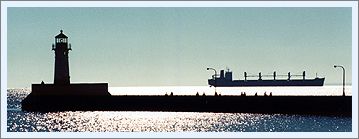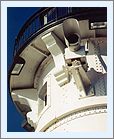|
Historical Information

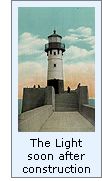 Although the South
Breakwater light had served to guide vessels into the Duluth
Shipping Canal since 1874, the canal itself was
only three-hundred feet wide, and making way between the two protective
piers was exceedingly difficult under the darkness of night or in the
thick fogs that frequently blanketed the area. To make matters worse,
the north pier was located so close to the shore that any vessel
misjudging the width of the channel stood a good chance of ending up on
the rocky shore to the north of the pier. After the Lake Carrier's Association's repeated
requests for a light to mark the end of the north pier went unheeded,
the Association took matters into its own hands with the installation of
a temporary light at the outer end of the north pier in 1908.
Although the South
Breakwater light had served to guide vessels into the Duluth
Shipping Canal since 1874, the canal itself was
only three-hundred feet wide, and making way between the two protective
piers was exceedingly difficult under the darkness of night or in the
thick fogs that frequently blanketed the area. To make matters worse,
the north pier was located so close to the shore that any vessel
misjudging the width of the channel stood a good chance of ending up on
the rocky shore to the north of the pier. After the Lake Carrier's Association's repeated
requests for a light to mark the end of the north pier went unheeded,
the Association took matters into its own hands with the installation of
a temporary light at the outer end of the north pier in 1908.
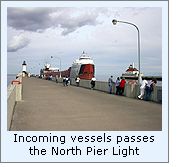 The Association's action evidently
provided the necessary impetus for the Lighthouse Board to
recommend an appropriation of $4,000 for the construction of a
permanent government aid to navigation at the outer end of the pier in
its 1908 annual report. With accompanying pressure from the Lake Carrier's
Association, Congress appropriated the requested funds on March 4, 1909.
In uncharacteristic urgency, under the direction of Eleventh District
Engineer Major Charles Keller, the plans for the PÍche Island lighthouse
were quickly modified for use on the Duluth pier, contracts were awarded, and
materials delivered at the Detroit depot by fall of that same year. Work
on the pier also started that fall, and after a break in the action as winter's icy grip took over the pier, continued at the opening of
navigation in 1910. The Association's action evidently
provided the necessary impetus for the Lighthouse Board to
recommend an appropriation of $4,000 for the construction of a
permanent government aid to navigation at the outer end of the pier in
its 1908 annual report. With accompanying pressure from the Lake Carrier's
Association, Congress appropriated the requested funds on March 4, 1909.
In uncharacteristic urgency, under the direction of Eleventh District
Engineer Major Charles Keller, the plans for the PÍche Island lighthouse
were quickly modified for use on the Duluth pier, contracts were awarded, and
materials delivered at the Detroit depot by fall of that same year. Work
on the pier also started that fall, and after a break in the action as winter's icy grip took over the pier, continued at the opening of
navigation in 1910.
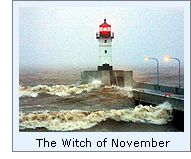 Over the
following months, a beautiful iron tower
took shape on the concrete pierhead. Standing 36 feet tall from base to
ventilator ball, the tower measured ten and a half feet in diameter at
the base, gracefully tapering to a diameter of 8 feet at the gallery,
which was supported by a series of gracefully curving cast-iron corbels.
Centered on the gallery, an octagonal cast-iron lantern with vertical
astragals contained a Fifth Order
Fresnel lens manufactured by Henry-Lepaute of Paris in
1881. The lens was to be illuminated by a 210-candlepower Over the
following months, a beautiful iron tower
took shape on the concrete pierhead. Standing 36 feet tall from base to
ventilator ball, the tower measured ten and a half feet in diameter at
the base, gracefully tapering to a diameter of 8 feet at the gallery,
which was supported by a series of gracefully curving cast-iron corbels.
Centered on the gallery, an octagonal cast-iron lantern with vertical
astragals contained a Fifth Order
Fresnel lens manufactured by Henry-Lepaute of Paris in
1881. The lens was to be illuminated by a 210-candlepower 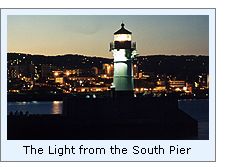 incandescent
electric lamp, with power supplied by the Duluth Electric Utility.
Equipped with an electromechanical flashing mechanism, the light would
display an isophase characteristic repeating 4-second cycle consisting
of 2-seconds of light followed by two-seconds of darkness. The tower's
location atop the concrete pier provide the lens with a focal plane of
46 feet, and a range of visibility of 11 miles under clear conditions.
incandescent
electric lamp, with power supplied by the Duluth Electric Utility.
Equipped with an electromechanical flashing mechanism, the light would
display an isophase characteristic repeating 4-second cycle consisting
of 2-seconds of light followed by two-seconds of darkness. The tower's
location atop the concrete pier provide the lens with a focal plane of
46 feet, and a range of visibility of 11 miles under clear conditions.
With work complete, the new light was
exhibited for the first time on the night of April 7, 1910, and the
light has been faithfully serving maritime interests entering and
departing Duluth Harbor since that date.

Keepers of
this Light

Click
here to see a complete listing of all keepers of the Duluth
Light compiled by Phyllis L. Tag of Great Lakes Lighthouse Research.

Seeing these
Lights
As is the
case with both of the piers lining the canal, the North pier was easy to
find, and we walked its length a number of times during our stay in this
surprising city.
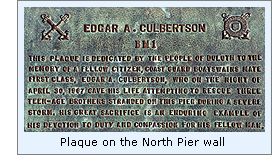 We were particularly
moved by an inconspicuous bronze plaque mounted to the wall of the North
breakwater. This simple plaque could have easily been overlooked, but
fortunately caught our eye as we sat on the wall to rest. Please click
on the image to the right to view a larger image, and read about Edgar
Culbertson's selfless heroism. We were particularly
moved by an inconspicuous bronze plaque mounted to the wall of the North
breakwater. This simple plaque could have easily been overlooked, but
fortunately caught our eye as we sat on the wall to rest. Please click
on the image to the right to view a larger image, and read about Edgar
Culbertson's selfless heroism.
While on the North
pier, we visited the Canal Park Maritime Museum, which is run by the
Army Corps of Engineers, and located tight against the lift bridge. We
found this to be a fascinating museum, with various displays relating to
Great Lakes shipping history, and highly recommend including a visit
during any visit to Duluth. Museum hours vary
by season. Summer hours generally are 10 a.m. to 9 p.m. daily; Spring
and Fall hours are 10 a.m. to 4:30 p.m. daily, and Winter hours are 10
a.m. to 4 p.m. Friday through Sunday. For more information, call the
museum at (218) 727-2497

Finding this Light

Hwy 61 slices through Duluth parallel to the lakeshore. All three Duluth
lighthouses are located on piers protecting the canal through a long
sand bar which protects the Port of Duluth, and are all located in
an area known as Canal Park, which is well signed. From Hwy 61, take
Canal Park Drive into Canal Park drive, and find a place to park. The North
Pierhead Light is located at the end of the pier
on the North side of the canal, and both South lights are (naturally)
located on the South side of the canal, which can be reached by walking
across the lift bridge. If the horn sounds followed by a message to
"clear the bridge" is heard, be sure to get off the bridge
quickly, as they do not give.

Reference
Sources
 Annual reports of the Lighthouse Board,
1907 through 1913 Annual reports of the Lighthouse Board,
1907 through 1913
Annual report of the Lake Carriers Association, 1909
Great Lakes Light Lists, 1924 - 1953
Inventory of Historic Light Stations,
National Parks Service,
1994.
The Northern Lights, Charles K. Hyde, 1995
Personal visit to Duluth Harbor on
09/06/1999
Photographs courtesy Jeff Laser of TOOT.
Historic postcard from author's collection.
Keeper listings for this light appear
courtesy of Great
Lakes Lighthouse Research
|

